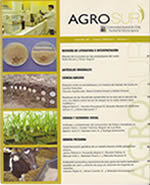Isolation of hydrolytic microorganisms from algal polysaccharides
Main Article Content
Abstract
The aim of this study was to understand the diversity of hydrolytic microorganisms (M.O.) associated with the brown alga Macrocystis pyrifera (L.) C. Agardh during its advanced state of decomposition. Algae have great commercial interest mainly due to their use as gelling agent, their nutritional composition and their use as raw material in the pharmaceutical industry. In recent years it has been described that microorganisms associated with these algae have the ability to degrade algal polysaccharides. Therefore, this study evaluated the degradation capacity of 4 algal polysaccharides (laminarin, carrageenan, agar and alginate). Samples of M. pyrifera were taken from three coastal sites: Puerto Montt, Osorno and Niebla. The samples from Osorno and Niebla presented, within their biota of microorganisms, 64% bacteria, 21% molds and 15% yeasts. However, yeast was not present in samples from Puerto Montt. Furthermore, it was found that not all microorganisms have the same hydrolytic capacity according to the temperature at which they were incubated, suggesting that proliferation of these microorganisms is regulated by different abiotic factors such as pH, temperature and salinity.

